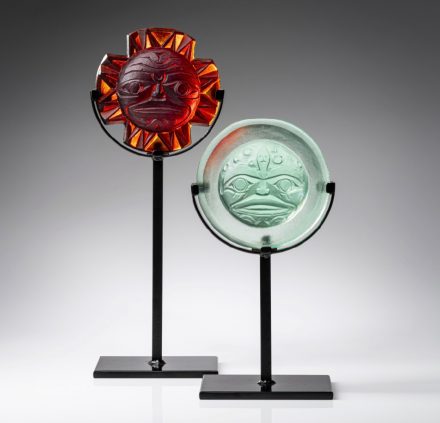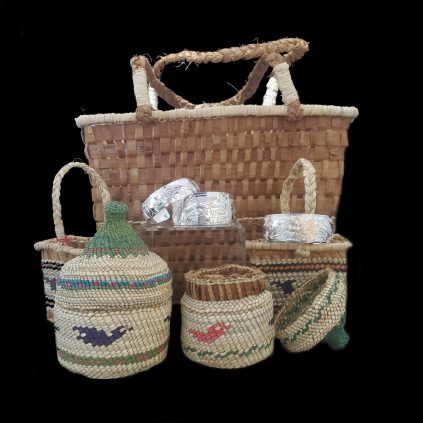Editor’s note: In our latest collaboration with Indigenous Tourism British Columbia, we’re putting five businesses on your radar as you shop for loved ones this holiday season. Aside from the chance to purchase original gifts, shopping Indigenous contributes to the economic well-being of First Nations communities at a grassroots level. What’s more, reaching out — in person, virtually or by telephone — provides the occasion to meet people in Canada you might not otherwise get to know. Why not let your holiday shopping, or shopping any time of year for that matter, open the doors to meaningful new connections along the way? — Kim Gray

Moccasins by Carol Gladue / Photo courtesy www.giftngab.ca
Gift ‘n Gab Trading Post / Barriere, BC
Speaking with Gift ‘n Gab Trading Post owner Kathie Heard leaves a warm impression. Heard, a member of the Wet’suwet’en First Nation, strives to make her shop a community-minded place where everyone feels welcome.
“We’re not a big box store. We’re a small, locally owned shop,” she says of the trading post, which opened in 2016 and is located on Highway 5 just north of Kamloops. “We want visitors to check us out, have a chat and not feel like they have to buy anything.”
Heard’s patrons come from everywhere, she says, and many are Indigenous. “They come by because of what we call the ‘Moccasin Trail’ — where someone visits and then they go home and tell their friends and family about us. They like that my shop is Indigenous-owned.”
Artists featured at the Gift ‘n Gab Trading Post include internationally renowned Squamish and Kwakwaka’wakw carver Richard Baker and jewelry designer and carver Nancy Dawson, who was born in Alert Bay on Cormorant Island.
There’s Michael Forbes as well, whose roots trace back to Haida Gwaii and who designs quality decorative pieces for the home, including bowls, wine glasses and candle holders.
Heard also carries beautifully crafted moccasins (see above) — created by Carol Gladue, a Métis artisan from Fort Chipewyan — that are “bestsellers, really cozy and totally, 100-per-cent handmade.”
Business aside, the entrepreneur says what she loves most about running Gift ‘n Gab Trading Post is the chance to swap stories with visitors. “People often stay for more than an hour. We hear sometimes that after they leave, they feel like they just made a friend.”

Umbrella design by Maynard Johnny Jr. / Photo courtesy www.skwachays.com
Skwachàys Lodge Aboriginal Hotel & Gallery / Vancouver BC
Skwachàys Lodge, a boutique hotel that features uniquely themed suites and an Indigenous Fair Trade Gallery, opened in 2012.
The lodge is unique in that it also functions as a social enterprise that directly supports an Indigenous artist-in-residence program designed to help artists get traction early in their careers.
David Eddy, CEO of the Vancouver Native Housing Society which founded the hotel, says the operation is distinct in Canada and beyond. “Time magazine created a list of the 100 greatest places in the world, and we were honoured to be on that list,” Eddy says, referencing an article called The World’s Greatest Places (2018).
The hotel’s gallery features several artists, including Victoria Harper, who gallery manager Lakshmi McCall says gets loads of custom orders. “She did my wedding band, and my husband’s, too,” says McCall of the jewelry maker, who comes from a Kwakwaka’wakw, Carrier and Cree background.
Richard Shorty, a Northern Tutchone painter from Whitehorse, Yukon, is another sought-after artist represented by Skwachàys. “He’s the most gentle person,” says McCall. “His art is central to the lodge’s Hummingbird, King Salmon and Feather-themed suites.”
Coast Salish artist-in-residence Maynard Johnny Jr. — renowned for his vibrant use of colour (see above) — maintains that the lodge has been critical to helping his professional life move forwards. “I love it here,” he says. “I’m surrounded by carvers, jewelry makers, actors and writers. We all support each other.”
Unfortunately, given the pandemic, McCall says Skwachàys Lodge has fallen on hard times. “We’re counting on gallery sales and a fundraising initiative to cover costs that would normally be serviced by hotel guests. It would be a shame if we had to close.”

Art by Ed NoiseCat / Photo by NoiseCat Art courtesy www.slcc.ca
Squamish Lil’wat Cultural Centre Gallery & Gift Shop / Whistler, BC
Victoria Saddleman, a retail supervisor at the Squamish Lil’wat Cultural Centre, says she considers everything she sells at the centre’s Gift Shop a piece of art.
“We carry inventory that is crafted directly by Indigenous artists, comes from Indigenous-owned businesses like Winnipeg’s Manitobah Mukluks and — in the case of mass produced products like water bottles — features designs by Indigenous artists who are compensated for their work,” Saddleman explains.
The 22-year-old retail supervisor, whose mom is from the Lil’wat Nation, is a graduate of the centre’s Indigenous Youth Ambassador Program, which teaches business skills through a First Nations lens and is supported by Gift Shop sales.
She highlights two other program graduates who now sell their wares at the shop: Travis Billy of the Squamish Nation, who produces a wide range of Salish wool weaving — including wall hangings, head bands, bracelets and purses — and Lil’wat Nation member Redmond Andrews, who creates carvings and cedar baskets.
Andrews recently apprenticed with the acclaimed Salish artist Ed Archie NoiseCat, who was invited by the centre earlier this year to celebrate his lifetime achievements.
The 24-year-old apprentice says he was happy for the experience with NoiseCat because he had originally learned to carve from his dad, who passed away in 2010. “I inherited my father’s knives and I’ve been teaching myself ever since,” says Andrews. “I’m planning to do art for the rest of my life. I love that you can create something from your own thoughts, your own mind, your own spirit.”
Inventory at the centre’s Gift Shop also includes everything from books and home accessories to gifts for children, says Saddleman. “And given the season, we’re now offering a ‘cleansing kit’ gift box that can be pre-ordered. It comes with a medicine pouch, essential oils, a face mask and spirit stones — a good gift for anyone who wants to shed 2020 and start a fresh, new beginning in 2021.”

Model: Marlo Wylie Brillon / Photo courtesy www.totemdesignhouse.ca
Totem Design House / Courtenay, BC
Erin Brillon, the owner of Totem Design House — the source of the wonderful lead image for this post — grew up surrounded by Indigenous art and artists.
“From when I was nine, my mom would take me to Vancouver’s Museum of Anthropology and it resonated right to my soul,” says the entrepreneur, who comes from a Haida and Cree background.
Brillon’s mom eventually travelled to France in 1989 when paddlers took artist Bill Reid’s legendary canoe “Lootaas” (“Wave-eater”) on a seven-day journey on the Seine River, coinciding with a Haida art exhibit at the Musée de l’Homme.
“I was in high school at the time and was able to bring news clippings into class showing the international spotlight on our art work,” recalls Brillon, who refers to this period of history as a “glamorous” time in the Indigenous art scene. “I was surrounded by galleries, pole raisings and urban feasts. The only people my mom knew were artists from Prince Rupert and Haida Gwaii. I was raised with this, to be in awe of our art forms.”
Brillon went on to spend years working in health, wellness and Indigenous empowerment, but kept feeling pulled back towards the art world.
She eventually launched Totem Design House with her brother Jesse Brillon, an established artist who creates “museum quality” jewelry and carvings. More recently, she teamed up with her life partner Andy Everson, a prominent K’ómoks and Kwakwaka’wakw artist, to create Kwigwatsi Studio & Showroom — a new space for their artistic adventures, where they can be “rooted in age-old traditions” but also “express ancestral artwork in contemporary ways.”
“Our sci fi-inspired apparel with Andy’s designs and our eco-friendly women’s wear are our biggest sellers,” says Brillon. “We create eco-friendly apparel, home decor, jewelry and fine art. We do it all with a focus on quality and respectability. Our goal with our new studio is to create a place that will help our communities thrive.”
She clarifies that “buying from us, wearing our clothes or our jewelry, is not cultural appropriation, not when you’re directly supporting authentic Indigenous businesses. I’d like to see people de-colonize the holidays — so not buy from Walmart, but support local, Indigenous-owned businesses and native artists. Actions like this genuinely make a difference.”

Basketry by Christina Cox / Bracelets by Harold Alfred, Noel Brown & Chris Cook / Photo by Carli Pryce courtesy www.ihosgallery.com
I-Hos Gallery / Courtenay, BC
Ramona Johnson of I-Hos Gallery, owned and operated by the K’ómoks First Nation and currently celebrating its 25th anniversary, says she’s always wanted to champion young creatives in the early stages of their careers.
“While we still support established artists, we’ve always been that place that tries to nurture young artists as they come up. We do our best and give advice and direction in a kind, caring manner,” says the ever-enthusiastic gallery manager.
“We’re proud to say that we knew people like Noel Brown and Andy Everson when they were just starting out and now we’re encouraging the next generation of artists in these families,” she continues. “Noel’s son, Richie, came to us when he was just a young teenager, with five beautiful little ornamental dug-out canoes. We love that Richie has taken up the carving tools, and that the father/son duo keep those wood chips flying together in their carving shed.”
Johnson says jewelry is one of the biggest draws at I-Hos Gallery and points to artists such as Chris Cook, “who you can find tucked away in Alert Bay working on his pieces,” and Harold Alfred, whose ‘love bird’ design is popular with couples of all ages “looking for gifts to honour their partners.”
Bill Helin’s plush finger puppets for young children are also a big hit with store patrons this holiday season. Helin, an established artist with Tsimshian and Norweigian roots is well known for works that involve everything from carving to books to designing a patch with NASA for Canadian astronaut Robert Thirsk.
Helin recalls thoroughly enjoying his collaboration with astronaut Thirsk. “Bob and I have become close friends. That project turned out to be a great space adventure for me,” he says. “I’ve also loved working with Ramona at I-Hos Gallery. Our relationship goes back 15 years. What she does and how she does it gives artists pride and motivates young people. There’s really only a handful of people out there like her.”
Johnson explains that, ultimately, when people support businesses like I-Hos Gallery, a whole community feels the impact.
“We carry basket weaving by Nuu-Chah-Nulth First Nations elder Christina Cox. In her younger days, she would pick all her own cedar during harvesting time and she would dye her own seagrass. Now, the younger ones bring materials to her. She’s such a treasure,” says the gallery manager.
“Let me put it this way. When you buy from us, we can purchase more from our artists, which in turn keeps a roof over their heads and meals on their tables.”
This post was powered by Indigenous Tourism British Columbia
Founded by two Canucks on the loose in a big country, Toque & Canoe is an award-winning Canadian travel blog. Follow us on Twitter, Instagram and Facebook


Nat Gillis commented:
Awesome post! Thanks for helping me narrow down my holiday shopping 🙂
Margo commented:
Love it! Great unique gift ideas.